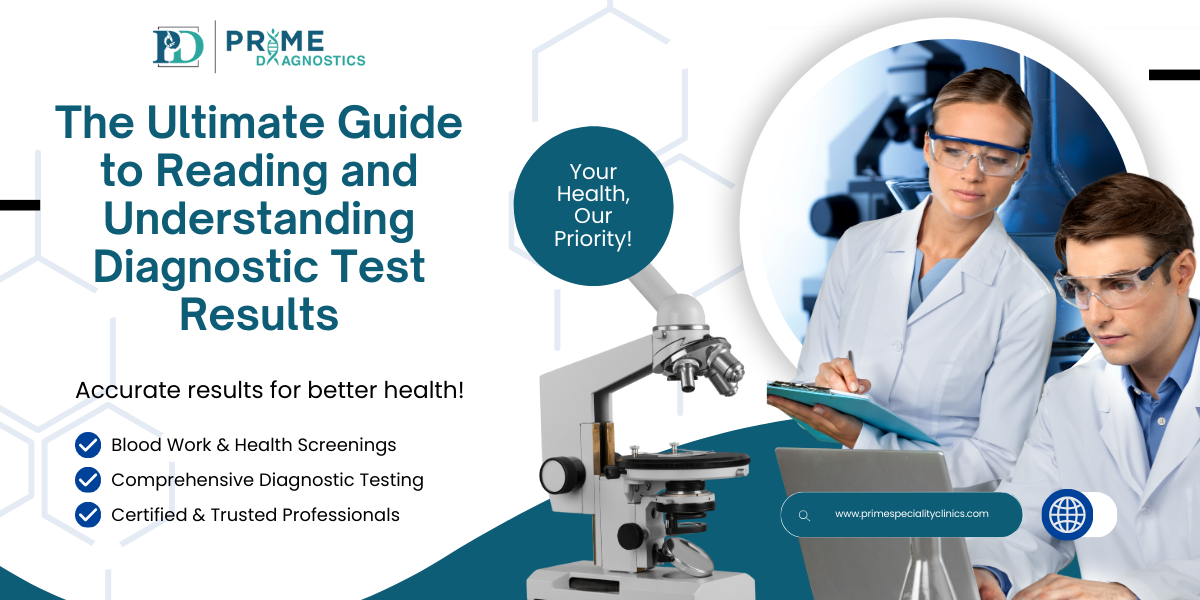
The Ultimate Guide to Reading and Understanding Diagnostic Test Results
Diagnostic test results play a crucial role in determining your overall health. They provide valuable information that helps doctors diagnose conditions, recommend treatments, and track your recovery. However, understanding medical test results can be overwhelming due to the complex medical terminology involved. In this guide, we'll break down how to read and interpret your diagnostic test results effectively, ensuring you're well-informed about your health.
Why Diagnostic Test Results Matter
Diagnostic tests including blood work, imaging scans, and urine tests are frequently requested when seeing a healthcare professional in order to assist detect possible health problems. Your doctor can use these data as a guide to decide what steps to go next with your care. To make well-informed decisions about your health, receiving accurate lab results is crucial, whether you're at Prime Diagnostics or any other healthcare facility.
Common Types of Diagnostic Tests
- Blood Tests
- Blood tests provide essential data about your overall health. They can assess things like your cholesterol levels, blood sugar, liver and kidney function, and even detect infections or other diseases. The results often include values such as white blood cell count, hemoglobin, and platelet count, among others.
- Urine Tests
- Urinalysis is commonly used to check for signs of disease or infection. It can detect issues like urinary tract infections, kidney problems, or diabetes by analyzing the chemical composition of your urine.
- Imaging Tests
- Imaging tests such as X-rays, MRIs, and CT scans provide a visual assessment of your internal organs and tissues. These are often used to diagnose fractures, tumors, or internal injuries.
How to Read Your Diagnostic Test Results
Results from diagnostic tests typically include a reference range, or the typical range of values for a healthy person. It's crucial to realize that "normal" can differ significantly depending on the lab, thus it's critical to compare your results to the specified reference ranges. You can analyze your results as follows:
- Identify the test: Make sure you understand what each test is measuring. For example, a complete blood count (CBC) measures different components of your blood, like red blood cells and hemoglobin.
- Check the reference range: Compare your numbers to the reference range. If your numbers fall outside the range, it doesn’t necessarily mean something is wrong, but it should be discussed with your doctor.
- Understand units of measurement: Test results are reported in specific units like milligrams per deciliter (mg/dL) or grams per liter (g/L). These units can vary depending on the test.
The Importance of Accurate Lab Results
Accurate lab results are essential for diagnosing conditions and determining the appropriate treatment plan. A small error in the lab could lead to a misdiagnosis, unnecessary treatments, or delays in getting the care you need. Reputable labs, such as those affiliated with Prime Diagnostics, adhere to strict quality standards to ensure that their results are both accurate and timely.
Additionally, certain factors can impact the accuracy of your test results. For instance, if you didn’t follow specific pre-test instructions—such as fasting for a blood sugar test—your results may not be accurate. Always make sure to follow your doctor’s guidelines closely before undergoing any tests.
How to Prepare for Diagnostic Tests
To ensure the most accurate results, you may need to follow certain steps before your test. These might include:
- Fasting: Some blood tests require you to fast for 8-12 hours before the test to ensure accurate readings.
- Avoiding certain medications: In some cases, medications can interfere with the results of diagnostic tests. Always inform your healthcare provider about any medications you're taking.
- Staying hydrated: Dehydration can affect your blood and urine test results, so make sure to drink plenty of water before your appointment.
Understanding the Bigger Picture
Your diagnostic test results are just one piece of the puzzle. Your doctor will use them in conjunction with your medical history, physical exams, and other tests to get a complete understanding of your health. It’s important to stay proactive, ask questions, and fully understand the implications of your results.
In conclusion, reading and understanding your diagnostic test results doesn’t have to be confusing. Whether you’re interpreting lab data from Prime Diagnostics or another medical facility, having the right information empowers you to take control of your health. Always consult with your healthcare provider for a comprehensive explanation of your results and the next steps in your treatment plan.
By staying informed, you can make better decisions about your health and well-being.